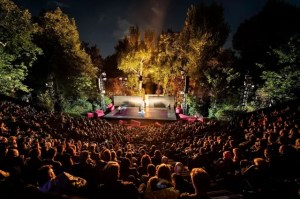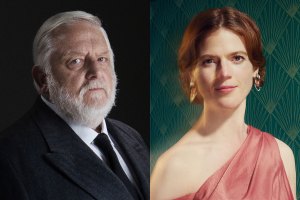The Tempest with Sigourney Weaver review – a production stripped of poetry and wonder
Jamie Lloyd’s revival continues at Theatre Royal Drury Lane until 1 February

It had to happen. After an unbroken voyage of success beginning with his Pinter season in 2018 and sailing through Evita, Cyrano and The Seagull to The Effect and Sunset Boulevard last year, the Jamie Lloyd theatrical cruiser has hit the rocks.
His new production of The Tempest starring Sigourney Weaver as a female Prospero, feels almost wilfully misconceived and under-achieved. A play that cries out for rethinking has been slammed foursquare on the Theatre Royal Drury Lane’s stage and left in a void of interpretation.
It looks dramatic, in what has become Lloyd’s signature style of greys and blacks. Soutra Gilmour has decided to present the enchanted island where Prospero spends her time in exile after being overthrown as Duchess of Milan as a dark slag heap. It looks like a scene from a dystopian sci-fi movie scoured by clouds of constantly billowing smoke, and shadows. The industrial soundscape by Ben and Max Ringham, with co-composer Michael ‘Mikey J’ Asante, and the stark lighting of Jon Clark, underpin this sense of gloom and danger.

Mason Alexander Park’s Ariel (quite the best thing in the entire production) emerges out of blackness on wires in the air above, surrounded by yellow clouds, or sweeps across the dirt wrapped in a diaphanous veil, singing with an air of threat. Forbes Masson’s Caliban lumbers around in a leather jockstrap looking as if he has dropped in from the Sean Connery not-so-classic Zardoz. Miranda (an impressive Mara Huf) looks like a castaway from Dune.
The unremitting mood of darkness is not leavened by any move towards hope or redemption. There is no sense that this is a play about revenge and forgiveness; the tone is unremitting.
As in his version of Romeo and Juliet, which starred Tom Holland and Francesca Amewudah-Rivers, Lloyd directs a lot of the speeches outwards, getting his cast to perform as if in a trance, moving in the preordained and stylised patterns of Fabian Aloise’s choreography. There are no props.
In Romeo and Juliet, this approach just about worked. But The Tempest is a much more complex and intractable play than that propulsive tragedy, and the abstraction of its telling not only slows the action down to a near halt, but also makes certain scenes (the plotting of the tiresome Trinculo and Stephano, played by Mathew Horne and Jason Barnett, for example) virtually incomprehensible.
No-one, apart from Selina Cadell who makes an honourable character of Gonzalo, one of the nobles of Milan that Prospero causes to be shipwrecked on the island, seems to have much idea about what they are saying. Weaver absolutely looks the part, commanding the stage with her charisma, brooding watchfully over the action, but she speaks in an unrelenting and perversely unrhythmic monotone.
She is not alone. The entire production is stripped of poetry or wonder but doesn’t offer any alternative revelation in its place. A programme note reminds us that when John Gielgud played Prospero on this stage in Peter Brook’s 1957 Tempest – the last time Shakespeare was performed at Drury Lane – he wasn’t the usual beneficent magician but a flawed human, made bitter with his desire for vengeance. When he broke his staff, abjuring magic, it meant something. It seems to sum up the barrenness of this production that Weaver has no staff to break.



















